List of French monarchs
France was ruled by monarchs from the establishment of the Kingdom of West Francia in 843 until the end of the Second French Empire in 1870, with several interruptions.[1][2]
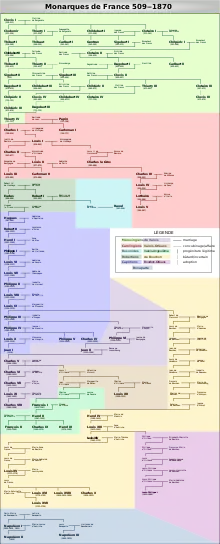
Classical French historiography usually regards Clovis I (r. 509–511) as the first king of France, however historians today consider that such a kingdom did not begin until the establishment of West Francia.[1][2]
Titles
The kings used the title "King of the Franks" (Latin: Rex Francorum) until the late twelfth century; the first to adopt the title of "King of France" (Latin: Rex Franciae; French: roi de France) was Philip II in 1190 (r. 1180–1223), after which the title "King of the Franks" gradually lost ground.[3] However, Francorum Rex continued to be sometimes used, for example by Louis XII in 1499, by Francis I in 1515, and by Henry II about 1550; it was also used on coins up to the eighteenth century.[4]
During the brief period when the French Constitution of 1791 was in effect (1791–1792) and after the July Revolution in 1830, the style "King of the French" (roi des Français) was used instead of "King of France (and Navarre)". It was a constitutional innovation known as popular monarchy which linked the monarch's title to the French people rather than to the possession of the territory of France.[5]
With the House of Bonaparte, the title "Emperor of the French" (Empereur des Français) was used in 19th-century France (during the first and second French Empires) between 1804 and 1814, again in 1815, and between 1852 and 1870.[6]
From the 14th century down to 1801, the English (and later British) monarch claimed the throne of France, though such claim was purely nominal excepting a short period during the Hundred Years' War when Henry VI of England had control over most of Northern France, including Paris. By 1453, the English had been mostly expelled from France and Henry's claim has since been considered illegitimate; French historiography commonly does not recognize Henry VI of England among the kings of France.
Frankish kings
On August 10, 843 AD, the Treaty of Verdun divided Francia into three kingdoms, one of which (Middle Francia) was short-lived; the other two evolved into France (West Francia) and, eventually, Germany (East Francia). By this time, the eastern and western parts of the land had already developed different languages and cultures.[7][8]
Carolingian dynasty (843–887)
The Carolingians were a Frankish noble family with origins in the Arnulfing and Pippinid clans of the 7th century AD. The family consolidated its power in the 8th century, eventually making the offices of mayor of the palace and dux et princeps Francorum hereditary and becoming the real powers behind the Merovingian kings. The dynasty is named after one of these mayors of the palace, Charles Martel, whose son Pepin the Short dethroned the Merovingians in 751 and, with the consent of the Papacy and the aristocracy, was crowned King of the Franks.[9] Under Charles the Great (r. 768–814), better known as "Charlemagne", the Frankish kingdom expanded deep into Central Europe, conquering Italy and most of modern Germany. He was succeeded by his son Louis the Pious (r. 814–840), who eventually divided the kingdom between his sons. His death, however, was followed by a 3-year-long civil war that ended with the Treaty of Verdun. Modern France developed from West Francia, while East Francia became the Holy Roman Empire and later Germany.
| Portrait | Name | Reign | Succession | Life details |
|---|---|---|---|---|
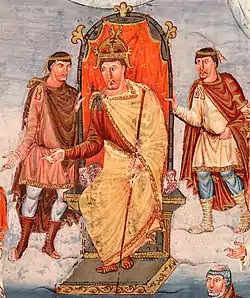 |
Charles II "the Bald"[lower-alpha 1] |
c. 10 October 843[lower-roman 1] – 6 October 877 (34 years and 2 months) |
Son of Louis the Pious and grandson of Charlemagne; recognized as king after the Treaty of Verdun | 13 June 823[lower-alpha 2] – 6 October 877 (aged 54) King of Aquitaine since 838. Crowned "Emperor of the Romans" on Christmas 875. Died of natural causes[12] |
 |
Louis II "the Stammerer"[lower-alpha 3] |
6 October 877[lower-roman 2] – 10 April 879 (1 year, 6 months and 4 days) |
Son of Charles the Bald | 1 November 846 – 10 April 879 (aged 32) King of Aquitaine since 867. Died of natural causes.[14] |
 |
Louis III | 10 April 879[lower-roman 3] – 5 August 882 (3 years, 3 months and 26 days) |
Son of Louis the Stammerer | 863 – 5 August 882[lower-alpha 4] (aged 19) Ruled the North; died after hitting his head with a lintel while riding his horse.[20] |
 |
Carloman II | 10 April 879[lower-roman 4] – 6 December 884 (5 years, 7 months and 26 days) |
Son of Louis the Stammerer | 866 – 6 December 884[lower-alpha 5] (aged 18) Ruled the South; died after being accidentlly stabbed by his servant.[24] |
 |
Charles (III) "the Fat"[lower-alpha 6] |
6 December 884[lower-roman 5] – 11 November 887[lower-alpha 7] (2 years, 11 months and 5 days) |
Son of Louis II the German, king of East Francia, and grandson of Louis I | 839[lower-alpha 8] – 13 January 888 (aged 48–49) King of East Francia since 876; crowned Emperor in 881. Last ruler to control all Frankish territories. Deposed by the nobility, later dying of natural causes[30] |
Robertian dynasty (888–898)
| Portrait | Name | Reign | Succession | Life details |
|---|---|---|---|---|
 |
Odo / Eudes | 29 February 888[lower-roman 6] – 3 January 898 (9 years, 10 months and 15 days) |
Son of Robert the Strong; elected king following the deposition of Charles III. Initially rivaled by Guy III of Spoleto and Ranulf II of Aquitaine | c. 858 – 3 January 898[lower-alpha 9] (aged approx. 40) Defended Paris from the Vikings; died of natural causes[35] |
Carolingian dynasty (898–922)
| Portrait | Name | Reign | Succession | Life details |
|---|---|---|---|---|
 |
Charles III "the Simple" |
3 January 898[lower-roman 7] – 29 June 922 (24 years, 5 months and 26 days) |
Posthumous son of Louis II the Stammerer; proclaimed king in opposition to Odo in January 893 | 17 September 879 – 7 October 929 (aged 50) Deposed by Robert's followers; later captured by Herbert II, Count of Vermandois. Died in captivity[36] |
Robertian dynasty (922–923)
| Portrait | Name | Reign | Succession | Life details |
|---|---|---|---|---|
 |
Robert I | 29 June 922[lower-roman 8]– 15 June 923 (11 months and 17 days) |
Son of Robert the Strong and younger brother of Odo | 865 – 15 June 923 (aged 58) Killed at the Battle of Soissons against Charles III. Sole king to die in battle[38] |
Bosonid dynasty (923–936)
| Portrait | Name | Reign | Succession | Life details |
|---|---|---|---|---|
 |
Rodolph / Raoul | 15 June 923[lower-roman 9]– 14 January 936 (12 years, 6 months and 30 days) |
Son of Richard, Duke of Burgundy and son-in-law of Robert I | Duke of Burgundy since 921. Died of illness after a reign of constant civil war and viking raids. Lose Lotharingia (Lorraine) to Henry I of Germany[39] |
Carolingian dynasty (936–987)
| Portrait | Name | Reign | Succession | Life details |
|---|---|---|---|---|
 |
Louis IV "from Overseas" |
19 June 936[lower-roman 10] – 10 September 954 (18 years, 2 months and 22 days) |
Son of Charles the Simple, recalled to France after being exiled to England | 921 – 10 September 954 (aged 33) Died after falling off his horse[40] |
.JPG.webp) |
Lothair | 10 September 954[lower-roman 11] – 2 March 986 (31 years, 5 months and 20 days) |
Son of Louis IV | 941 – 2 March 986 (aged 44) Died of natural causes[41] |
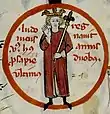 |
Louis V "the Do-Nothing" |
2 March 986[lower-roman 12] – 22 May 987 (1 year, 2 months and 20 days) |
Son of Lothair | 967 – 22 May 987[lower-alpha 11] (aged 20) Died in a hunting accident[43] |
Capetian dynasty (987–1792)
The Capetian dynasty is named for Hugh Capet, a Robertian who served as Duke of France and was elected King in 987. Except for the Bonaparte-led Empires, every monarch of France was a male-line descendant of Hugh Capet. The kingship passed through patrilineally from father to son until the 14th century, a period known as Direct Capetian rule. Afterwards, it passed to the House of Valois, a cadet branch that claimed descent from Phillip III. The Valois claim was disputed by the House of Plantagenet, founded by Geoffrey Plantagenet, Count of Anjou, which had also recently come into possession of the throne of England; the two houses fought the Hundred Years War over the issue, and with Henry VI of England being for a time partially recognized as King of France. The Valois line died out in the late 16th century, during the French Wars of Religion, to be replaced by the distantly related House of Bourbon, which claimed descent through the Direct Capetian Louis IX. The Bourbons would rule France until deposed in the French Revolution, though they would be restored to the throne after the fall of Napoleon's empire. The last Capetian to rule would be Louis Philippe I, king of the July Monarchy, a member of the cadet House of Bourbon-Orléans.
House of Capet (987–1328)
The House of Capet are also commonly known as the "Direct Capetians".
| Portrait | Name | Arms | Reign | Succession | Life details |
|---|---|---|---|---|---|
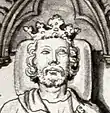 |
Hugh "Capet" Hugues Capet[lower-alpha 12] |
1 June 987[lower-roman 13] – 24 October 996 (9 years, 4 months and 23 days) |
Son of Hugh the Great and grandson of Robert I[lower-alpha 13] | c. 940 – 24 October 996 (aged approx. 55) Duke of the Franks since 956. Died of natural causes.[47] | |
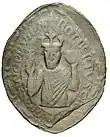 |
Robert II "the Pious" | 24 October 996[lower-roman 14] – 20 July 1031 (34 years, 8 months and 26 days) |
Only son of Hugh Capet | c. 970 – 20 July 1031 (aged approx. 60) Married thrice, getting excommunicated by the Catholic Church. Incorporated the Duchy of Burgundy[48] | |
| Hughes (junior king)[lower-alpha 14] |
19 June 1017 – 17 September 1025 (under Robert II) |
Son of Robert II | c. 1007 – 17 September 1025 (aged approx. 18)[49] | ||
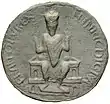 |
Henry I Henri |
20 July 1031[lower-roman 15] – 4 August 1060 (29 years and 15 days) |
Son of Robert II | c. 1005 – 4 August 1060 (aged approx. 55) His reign was marked with internal struggle against feudal lords[50] | |
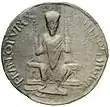 |
Philip I "the Amorous" Philippe |
4 August 1060[lower-roman 16] – 29 July 1108 (47 years, 11 months and 25 days) |
Son of Henry I | 1052 – 29 July 1108 (aged 56) Ruled under the regency of Anne of Kiev and Count Baldwin V until 1066[51] | |
 |
Louis VI "the Fat" | 29 July 1108[lower-roman 17] – 1 August 1137 (29 years and 3 days) |
Son of Philip I | 1081 – 1 August 1137 (aged 56) His reign contributed to the centralization of royal power. First king to wage war against the English[52] | |
| Philippe (junior king)[lower-alpha 14] |
14 April 1129 – 13 October 1131 (under Louis VI) |
Son of Louis VI | 29 August 1116 – 13 October 1131 (aged 15)[53] | ||
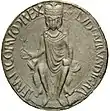 |
Louis VII "the Young" | 1 August 1137[lower-roman 18] – 18 September 1180 (43 years, 1 month and 17 days) |
Son of Louis VI | 1120 – 18 September 1180 (aged 60) Known for his rivalry with Henry II of England and his military campaigns during the Second Crusade[54] | |
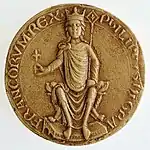 |
Philip II "Augustus" Philippe Auguste |
.svg.png.webp) |
18 September 1180[lower-roman 19]– 14 July 1223 (42 years, 9 months and 26 days) |
Son of Louis VII | 21 August 1165 – 14 July 1223 (aged 57) Regarded as one of the greatest French rulers. First monarch to style himself as "King of France"[55] |
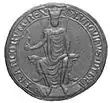 |
Louis VIII "the Lion" | 14 July 1223[lower-roman 20]– 8 November 1226 (3 years, 3 months and 25 days) |
Son of Philip II | 5 September 1187 – 8 November 1226 (aged 39) Proclaimed king of England in 1216, after which he led an unsuccessful invasion[56] | |
.jpg.webp) |
Louis IX "the Saint" | 8 November 1226[lower-roman 21]– 25 August 1270 (43 years, 9 months and 17 days) |
Son of Louis VIII | 25 April 1214 – 25 August 1270 (aged 56) Ruled under the regency of Blanche of Castile until 1234. Died during the 8th Crusade; only king to be venerated by the Catholic Church[57] | |
.jpg.webp) |
Philip III "the Bold" Philippe |
25 August 1270[lower-roman 22]– 5 October 1285 (15 years, 1 month and 10 days) |
Son of Louis IX | 3 April 1245 – 5 October 1285 (aged 40) Greatly expanded French influence in Europe. Died of a fever[58] | |
.jpeg.webp) |
Philip IV "the Fair" Philippe |
.svg.png.webp) |
5 October 1285[lower-roman 23] – 29 November 1314 (29 years, 1 month and 24 days) |
Son of Philip III | 1268 – 29 November 1314 (aged 46) King of Navarre (as Philip I) since 16 August 1284, following his marriage with Joan I. Remembered for his struggle with the Roman papacy and his consolidation of royal power, which to helped reduce the influence of feudal lords[59] |
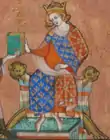 |
Louis X "the Quarreller" |
29 November 1314[lower-roman 24]– 5 June 1316 (1 year, 6 months and 7 days) |
Son of Philip IV | 3 October 1289 – 5 June 1316 (aged 26) King of Navarre (as Louis I) since 2 April 1305. His short reign was marked by conflicts with the nobility[60] | |
 |
John I "the Posthumous" Jean |
15–20 November 1316 (5 days) |
Posthumous son of Louis X | King for the five days he lived; shortest monarch in French history[61][lower-alpha 15] | |
.jpg.webp) |
Philip V "the Tall" Philippe |
20 November 1316[lower-roman 25]</ref>– 3 January 1322 (5 years, 1 month and 14 days) |
Son of Philip IV and uncle of John I | 1294 – 3 January 1322 (aged 28) King of Navarre as Philip II. Died without a male heir[62] | |
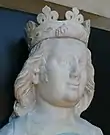 |
Charles IV "the Fair" | 3 January 1322[lower-roman 26]– 1 February 1328 (6 years and 29 days) |
Younger brother of Philip V | 1294 – 1 February 1328 (aged 34) King of Navarre as Charles I. Died without a male heir, ending the direct line of Capetians[63] |
House of Valois (1328–1589)
The death of Charles IV started the Hundred Years' War between the House of Valois and the House of Plantagenet (whose claim was taken up by the cadet branch known as the House of Lancaster) over control of the French throne. The Valois claimed the right to the succession by male-only primogeniture through the ancient Salic Law, having the closest all-male line of descent from a recent French king. They were descended from the third son of Philip III, Charles, Count of Valois. The Plantagenets based their claim on being closer to a more recent French king, Edward III of England being a grandson of Philip IV through his mother, Isabella. The two houses fought the Hundred Years War to enforce their claims; the Valois were ultimately successful, and French historiography counts their leaders as rightful kings. One Plantagenet, Henry VI of England, did enjoy de jure control of the French throne following the Treaty of Troyes, which formed the basis for continued English claims to the throne of France until 1801. The Valois line would rule France until the line became extinct in 1589, in the backdrop of the French Wars of Religion. As Navarre did not have a tradition of male-only primogeniture, the Navarrese monarchy became distinct from the French with Joan II, a daughter of Louis X.
| Portrait | Name | Arms | Reign | Succession | Life details |
|---|---|---|---|---|---|
 |
Philip VI "the Fortunate" Philippe |
.svg.png.webp) |
1 April 1328[lower-roman 27] – 22 August 1350 (22 years, 4 months and 21 days) |
Son of Charles, Count of Valois, grandson of Philip III and cousin of Charles IV | 1293 – 22 August 1350 (aged 57) His reign was dominated by the consequences of a succession dispute, which led to the Hundred Years' War.[64] |
 |
John II "the Good" Jean |
22 August 1350[lower-roman 28] – 8 April 1364 (13 years, 7 months and 17 days) |
Son of Philip VI | April 1319[lower-alpha 17] – 8 April 1364 (aged 45) Captured by the English at the Battle of Poitiers (1356); forced to sign a series of humiliating treaties[65] | |
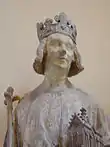 |
Charles V "the Wise" | .svg.png.webp) |
8 April 1364[lower-roman 29]– 16 September 1380 (16 years, 5 months and 8 days) |
Son of John II; named Dauphin on 16 July 1349 | 21 January 1337 – 16 September 1380 (aged 43) His reign was marked with internal struggle against feudal lords[66] |
 |
Charles VI "the Mad" "the Beloved" |
.svg.png.webp) |
16 Sept 1380[lower-roman 30]– 21 October 1422 (42 years, 1 month and 5 days) |
Son of Charles V | 3 December 1368 – 21 October 1422 (aged 58) Ruled under the regency of his uncles until 1388. Suffered a long period of mental illnes before dying of natural causes[67] |
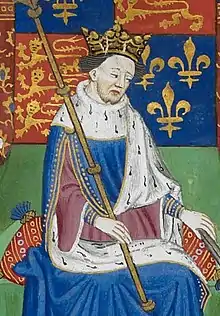 |
Henry VI of England (claimant) |
.svg.png.webp) |
21 October 1422[lower-roman 31]– 19 October 1453[lower-alpha 18] (disputed; 31 years) |
Maternal grandson of Charles VI; recognized as heir after the Treaty of Troyes of 21 May 1420 | 6 December 1421 – 21 May 1471 (aged 49) King of England since 1 September 1422. Ruled under several regencies until 1437[68] |
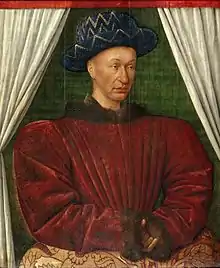 |
Charles VII "the Victorious" "the Well-Served" |
.svg.png.webp) |
21 October 1422[lower-roman 32] – 22 July 1461 (38 years, 9 months and 1 day) |
Son of Charles VI and uncle of Henry VI of England, named Dauphin in April 1417 | 22 February 1403 – 22 July 1461 (aged 58) His reign saw the end of the Hundred Years' War[69] |
.jpg.webp) |
Louis XI "the Prudent" "the Universal Spider" |
 |
22 July 1461[lower-roman 33] – 30 August 1483 (22 years, 1 month and 8 days) |
Son of Charles VII | 3 July 1423 – 30 August 1483 (aged 60) His reign saw the strengthening and expansion of royal power. Nicknamed "the Universal Spider" for the numerous intrigues during his rule[70] |
%252C_by_anonymous_artist%252C_16th_century_(cropped).jpg.webp) |
Charles VIII "the Affable" |
 |
30 August 1483[lower-roman 34] – 7 April 1498 (14 years, 7 months and 8 days) |
Son of Louis XI | 30 June 1470 – 7 April 1498 (aged 27) Ruled under the regency of his sister Anne until 1491. Started the long and unsuccessful Italian Wars. Died after hitting his head with a lintel[71] |
House of Valois-Orléans (1498–1515)
| Portrait | Name | Arms | Reign | Succession | Life details |
|---|---|---|---|---|---|
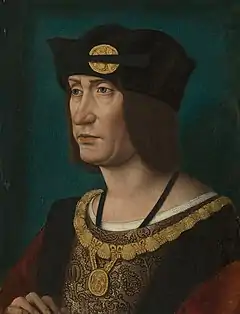 |
Louis XII "Father of the People" |
 |
7 April 1498[lower-roman 35] – 1 January 1515 (16 years, 8 months and 25 days) |
Great-grandson of Charles V. Second cousin, and by first marriage son-in-law, of Louis XI | 27 June 1462 – 1 January 1515 (aged 52) Briefly conquered the Kingdom of Naples and the Duchy of Milan[72] |
House of Valois-Angoulême (1515–1589)
| Portrait | Name | Arms | Reign | Succession | Life details |
|---|---|---|---|---|---|
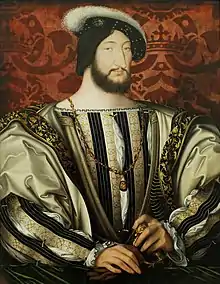 |
Francis I "the Father of Letters" François |
 |
1 January 1515[lower-roman 36] – 31 March 1547 (32 years, 2 months and 30 days) |
Great-great-grandson of Charles V. First cousin once removed, and by first marriage son-in-law, of Louis XII | 12 September 1494 – 31 March 1547 (aged 52) Remembered as a Renaissance patron of the arts and scholarship. Died of a fever[73] |
.jpg.webp) |
Henry II Henri |
31 March 1547[lower-roman 37] – 10 July 1559 (12 years, 3 months and 10 days) |
Son of Francis I, named Dauphin in August 1536 | 31 March 1519 – 10 July 1559 (aged 40) His reign saw the end of the Italian Wars. Died after being accidentally stabbed in a Jousting tournament[74] | |
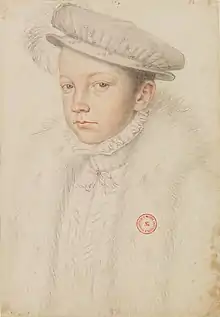 |
Francis II François |
10 July 1559[lower-roman 38] – 5 December 1560 (1 year, 4 months and 25 days) |
Son of Henry II | 20 January 1544 – 5 December 1560 (aged 16) King consort of Scotland since 24 April 1558. A weak and sick boy, he remained under the regency of the House of Guise until his premature death[75] | |
%252C_by_After_Fran%C3%A7ois_Clouet.jpg.webp) |
Charles IX | 5 December 1560[lower-roman 39] – 30 May 1574 (13 years, 5 months and 25 days) |
Younger brother of Francis II | 27 June 1550 – 30 May 1574 (aged 23) Ruled under the regency of his mother Catherine until 1563, but remained under her influence until his death. The Wars of Religion began under his reign (1562). Best remember for the Massacre of Vassy[76] | |
 |
Henry III Henri |
 |
30 May 1574[lower-roman 40] – 2 August 1589 (15 years, 2 months and 3 days) |
Younger brother of Charles IX | 19 September 1551 – 2 August 1589 (aged 37) Initially ruler of the Poland–Lithuania.[lower-alpha 19] He reigned through the devastating Wars of Religion, which eventually led to his own assassination[80] |
House of Bourbon (1589–1792)
The Valois line looked strong on the death of Henry II, who left four male heirs. His first son, Francis II, died in his minority. His second son, Charles IX, had no legitimate sons to inherit. Following the premature death of his fourth son Hercule François and the assassination of his third son, the childless Henry III, France was plunged into a succession crisis over which distant cousin of the king would inherit the throne. The best claimant, King Henry III of Navarre, was a Protestant, and thus unacceptable to much of the French nobility. Ultimately, after winning numerous battles in defence of his claim, Henry converted to Catholicism and was crowned as King Henry IV, founding the House of Bourbon. This marked the second time the thrones of Navarre and France were united under one monarch; as different inheritance laws had caused them to become separated during the events of the Hundred Years Wars. The House of Bourbon would be overthrown during the French Revolution and replaced by a short-lived republic.
| Portrait | Name | Arms | Reign | Succession | Life details |
|---|---|---|---|---|---|
_-_P2093_-_Mus%C3%A9e_Carnavalet.jpg.webp) |
Charles X (claimant) |
 |
2 August 1589 – 9 May 1590 (disputed; 9 months and 7 days) |
7x great-grandson of Louis IX. Proclaimed king by the Catholic League in opposition to Henry of Navarre | 22 December 1523 – 9 May 1590 (aged 66) Imprisoned by Henry III on 23 December 1588; remained his entire "reign" in captivity. Died of natural causes[81] |
_-_Henri_IV%252C_King_of_France_(1553-1610)_-_RCIN_402972_-_Royal_Collection.jpg.webp) |
Henry IV "the Great" "the Good King" Henri |
.svg.png.webp) |
2 August 1589[lower-roman 41] – 14 May 1610 (20 years, 9 months and 12 days) |
10th-generation descendant of Louis IX; also nephew of Charles (X) and son-in-law of Henry II. Proclaimed king on Henry III's deathbed | 13 December 1553 – 14 May 1610 (aged 56) King of Lower Navarre (as Henry III) since 10 June 1572. Killed in Paris on 14 May 1610 by Catholic fanatic François Ravaillac .[82] |
.jpg.webp) |
Louis XIII "the Just" | 14 May 1610[lower-roman 42] – 14 May 1643 (33 years) |
Son of Henry IV | 27 September 1601 – 14 May 1643 (aged 41) Last King of Lower Navarre (as Louis II).[lower-alpha 20] Died of natural causes.[83] | |
 |
Louis XIV "the Great" "the Sun King" |
14 May 1643[lower-roman 43] – 1 September 1715 (72 years, 3 months and 18 days) |
Son of Louis XIII | 5 September 1638 – 1 September 1715 (aged 76) Ruled under the regency of his mother Anne of Austria until 1651. Longest reigning sovereign monarch in history[84] | |
_edited_2.jpg.webp) |
Louis XV "the Beloved" |
1 September 1715[lower-roman 44] – 10 May 1774 (58 years, 8 months and 9 days) |
Great-grandson of Louis XIV | 15 February 1710 – 10 May 1774 (aged 64) Ruled under the regency of Philippe II, Duke of Bourbon-Orléans, until 1723[85] | |
%252C_rev%C3%AAtu_du_grand_costume_royal_en_1779_-_Google_Art_Project.jpg.webp) |
Louis XVI | 10 May 1774[lower-roman 45] – 21 September 1792[lower-alpha 21] (18 years, 4 months and 11 days) |
Grandson of Louis XV | 23 August 1754 – 21 January 1793 (aged 38) Forced to install a constitutional monarchy after 1789. Formally deposed following the proclamation of the First Republic; executed in public[86] |
Long 19th-century (1792–1870)
The period known as the "long nineteenth century" was a tumultuous time in French politics, the period is generally considered to have begun with the French Revolution, which deposed and then executed Louis XVI. Royalists continued to recognize his son, the putative king Louis XVII as ruler of France, however Louis was under arrest by the government of the Revolution, and died in captivity having never ruled. The republican government itself went through several changes in form and constitution until France was declared an empire following the ascension of the First Consul Napoleon Bonaparte as Emperor Napoleon I. Napoleon himself would be overthrown twice following military defeats during the Napoleonic Wars. After the Napoleonic period followed two different royal governments, the Bourbon Restoration, which was ruled successively by two younger brothers of Louis XVI, and the July Monarchy, ruled by Louis Philippe I, a distant cousin who claimed descent from Louis XIII. The French Revolution of 1848 brought an end to the monarchy again, instituting a brief Second Republic that lasted only four years before its President declared himself Emperor Napoleon III, who would himself be deposed and replaced by the Third Republic, and ending monarchic rule in France for good.
House of Bourbon, claimant (1792–1804)
| Portrait | Name | Arms | Reign | Succession | Life details |
|---|---|---|---|---|---|
 |
Louis XVII (claimant) |
.svg.png.webp) |
21 January 1793 – 8 June 1795 (disputed; 2 years, 4 months and 18 days) |
Son of Louis XVI; named Dauphin on 4 June 1789 | 27 March 1785 – 8 June 1795 (aged 10) Imprisoned by the revolutionary forces on 13 August 1792. Remained in captivity during the entirety of his "reign"[87] |
House of Bonaparte, First French Empire (1804–1814)
| Portrait | Name | Arms | Reign | Succession | Life details |
|---|---|---|---|---|---|
 |
Napoleon I | .svg.png.webp) |
18 May 1804[lower-roman 46] – 6 April 1814 (9 years, 10 months and 19 days) |
First Consul following the coup d'etat of 19 November 1799; self-proclaimed Emperor of the French | 15 August 1769 – 5 May 1821 (aged 51) Conquered most of Europe in a series of successful wars; remembered as one of the greatest military commanders in history. Forced to abdicate and exiled to the island of Elba[88] |
House of Bourbon (1814–1815)
| Portrait | Name | Arms | Reign | Succession | Life details |
|---|---|---|---|---|---|
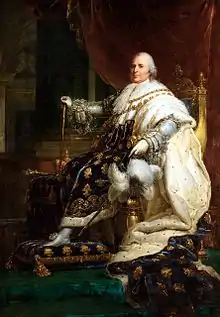 |
Louis XVIII "the Desired" |
.svg.png.webp) |
3 May 1814[lower-roman 47] – 20 March 1815 (1st time; 10 months and 17 days) |
Younger brother of Louis XVI; proclaimed king in June 1795 | 17 November 1755 – 16 September 1824 (aged 68) Fled France on 21 June 1791, during the Flight to Varennes.[89] |
House of Bonaparte, Hundred Days (1815)
| Portrait | Name | Arms | Reign | Succession | Life details |
|---|---|---|---|---|---|
 |
Napoleon I | .svg.png.webp) |
20 March – 22 June 1815 (94 days) |
Restored as Emperor of the French following his escape from the island of Elba. | 15 August 1769 – 5 May 1821 (aged 51) Abdicated in favour of his son following his defeat at the Battle of Waterloo. Exiled to the island of Saint Helena, where he later died of a stomach illness[88] |
.jpg.webp) |
Napoleon II (claimant) |
22 June – 7 July 1815 (15 days; disputed) |
Son of Napoleon I | 20 March 1811 – 22 July 1832 (aged 21) Remained his entire "reign" hidden in Austria, with his mother Marie Louise. Died of tuberculosis several years later[90] |
Bourbon Restoration (1815–1830)
| Portrait | Name | Arms | Reign | Succession | Life details |
|---|---|---|---|---|---|
 |
Louis XVIII "the Desired" |
.svg.png.webp) |
8 July 1815 – 16 September 1824 (9 years, 2 months and 8 days) |
Younger brother of Louis XVI; restored to the throne | 17 November 1755 – 16 September 1824 (aged 68) Attempted to rule under a constitutional monarchy. Last French monarch to die while still reigning[89] |
.jpg.webp) |
Charles X | 16 September 1824[lower-roman 48]– 2 August 1830 (5 years, 10 months and 17 days) |
Younger brother of Louis XVI and Louis XVIII | 9 October 1757 – 6 November 1836 (aged 79) Leader of the Ultra-royalists; attempted to return to the Ancient Regime. Abdicated in favour of his grandson Henry.[91] | |
 |
Louis XIX (claimant) |
2 August 1830 (a few minutes; disputed) |
Son of Charles X | 6 August 1775 – 3 June 1844 (aged 68) Allegedly king for 20 minutes before his own abdication;[lower-alpha 22] later legitimist pretender to the throne.[92] | |
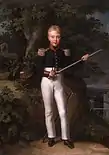 |
Henry V (claimant) |
2–9 August 1830 (7 days; disputed) |
Grandson of Charles X | 29 September 1820 – 24 August 1883 (aged 62) Later legitimist pretender to the throne. Died in exile several years later[93] |
House of Bourbon-Orléans, July Monarchy (1830–1848)
The Bourbon Restoration came to an end with the July Revolution of 1830 which deposed Charles X and replaced him with Louis Philippe I, a distant cousin with more liberal politics. Charles X's son Louis signed a document renouncing his own right to the throne only after a 20-minute argument with his father. Because he was never crowned he is disputed as a genuine king of France. Louis's nephew Henry was likewise considered by some to be Henry V but the new regime did not recognise his claim and he never ruled.
| Portrait | Name | Arms | Reign | Succession | Life details |
|---|---|---|---|---|---|
_by_Winterhalter.jpg.webp) |
Louis Philippe I "the Citizen King" |
.svg.png.webp) |
9 August 1830[lower-roman 49]– 24 February 1848 (17 years, 6 months and 15 days) |
Sixth-generation descendant of Louis XIII, also distant cousin of Charles X | 6 October 1773 – 26 August 1850 (aged 76) Styled as King of the French. Abdicated in favour of his grandson[94] |
 |
Louis Philippe II (claimant) |
24–26 February 1848 (2 days; disputed) |
Grandson of Louis-Philippe | 24 August 1838 – 8 September 1894 (aged 56) Later Orléanist pretender to the throne.[95] |
House of Bonaparte, Second French Empire (1852–1870)
The French Second Republic lasted from 1848 to 1852, when its president, Charles-Louis-Napoléon Bonaparte, was declared Emperor of the French under the regnal name of Napoleon III. He would later be overthrown during the events of the Franco-Prussian War, becoming the last monarch to rule France.
| Portrait | Name | Arms | Reign | Succession | Life details |
|---|---|---|---|---|---|
_-_Palace_of_Versailles.jpg.webp) |
Napoleon III | .svg.png.webp) |
2 December 1852[lower-roman 50]– 4 September 1870 (17 years, 9 months and 2 days) |
Nephew of Napoleon I and former President of France; self-proclaimed Emperor | 20 April 1808 – 9 January 1873 (aged 64) Captured by the German army on 2 September 1870; deposed following the proclamation of the Third Republic.[96] |
Later pretenders
Various pretenders descended from the preceding monarchs have claimed to be the legitimate monarch of France, rejecting the claims of the president of France and of one another. These groups are:
- Legitimist claimants to the throne of France: descendants of the Bourbons. Unionists recognized the Orléanist claimant after 1883.
- Blancs d'Espagne: descendants of Louis XIV, claiming precedence over the House of Bourbon-Orléans by virtue of primogeniture.
- Orléanist claimants to the throne of France: descendants of Louis-Phillippe, himself descended from a junior line of the Bourbon dynasty, rejecting all heads of state since 1848.
- Bonapartist claimants to the throne of France: descendants of Napoleon I and his brothers, rejecting all heads of state 1815–48 and since 1870.
- English claimants to the throne of France: kings of England and later of Great Britain (renounced by Hanoverian King George III upon union with Ireland in 1800).
- Jacobite claimants to the throne of France: senior heirs-general of Edward III of England and thus his claim to the French throne, also claiming England, Scotland, and Ireland.
Timeline
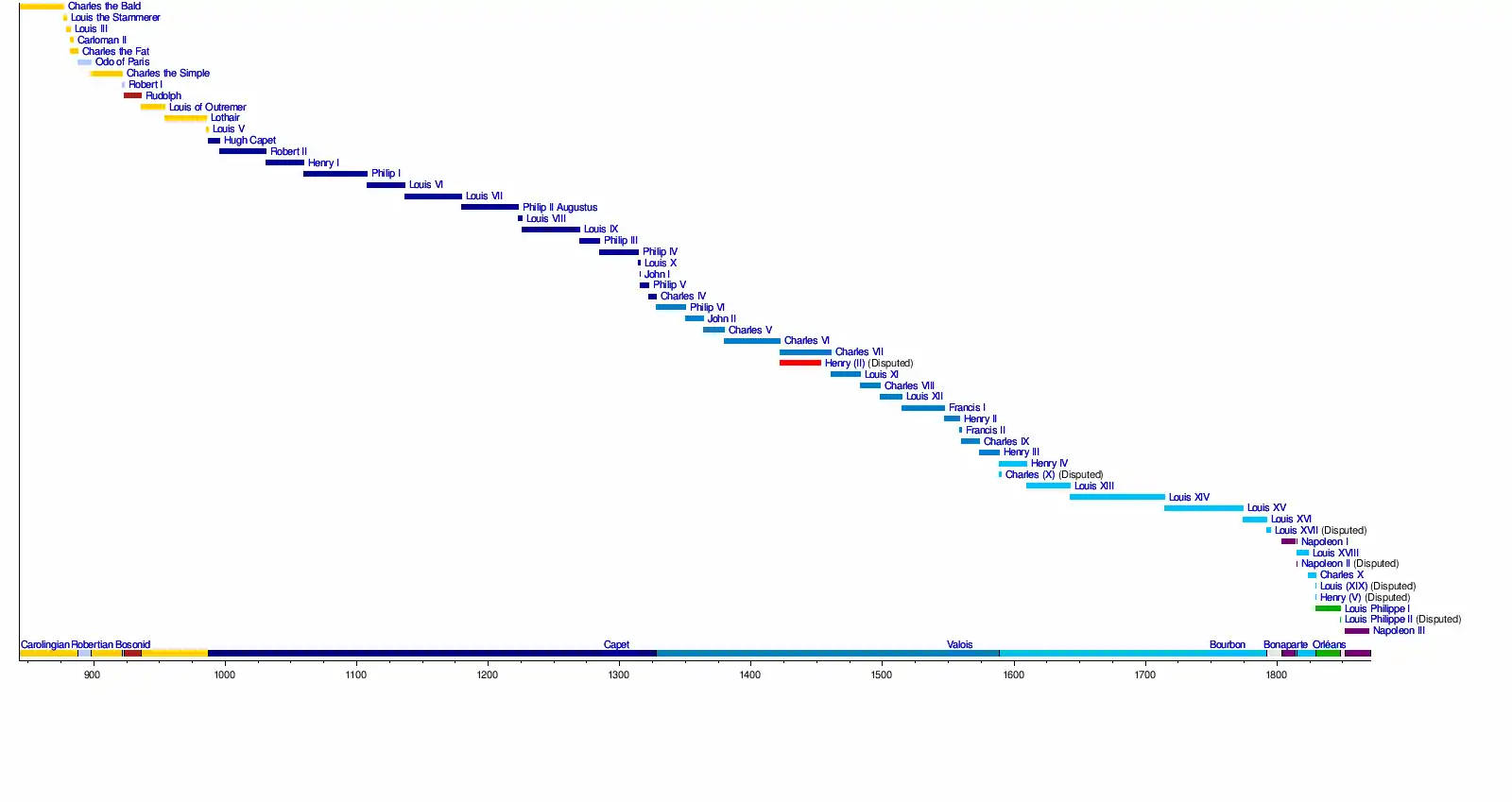
See also
- Family tree of French monarchs
- Family tree of French monarchs (simplified)
- Style of the French sovereign
- English claims to the French throne
- List of French royal consorts
- List of heirs to the French throne
- List of presidents of France
Notes
- Louis the Pious and Charlemagne are both enumerated as "Louis I" and "Charles I" in the lists of French and German monarchs.
- Older scholars give his birth as 15 May,[10] the ides of May. However, ancient sources record his birth as 13 June, the ides of June.[11]
- Not to be confused with Louis II the German, son of Louis the Pious and king of East Francia (Germany). Both French and German monarchs saw themselves as the successors of Charlemagne, hence why many rulers share the same regnal name.
- Scholars give his death as either 3,[16] 4,[17] or 10 August,[18] but ancient sources clearly indicates 5 August.[19]
- Some modern sources give his death as "12 December", but this is a mistake.[21][22][23]
- Charles the Fat was initially king of East Francia (Germany) and Holy Roman Emperor. Given that he was the third emperor with that name, he is also known as Charles III. He must not to be confused with Charles the Simple, who is also enumerated as Charles III. This discrepancy originates from the regnal number adopted by Charles V, the first French king to assume one.[25]
- This is the most accepted and cited date, although it's not entirely confirmed.[28][27]
- In older sources his birth was dated to 832, but nowadays 839 is the accepted date.[29]
- Odo's death is universally given as 1 January, as given by a late 13th century chronicle,[32] but the earliest source on the matter, from the early 11th century, records his death as 3 January.[33] Another source, from the 13th century, records his death as 2 January.[34]
- See main entry for references.
- Some scholars give his death as 21 May, but contemporary sources give 22 May.[42]
- "Capet" (latin: Cappetus) wasn't actually a name, but a nickname adopted by later historians. It probably derived from chappe, an ecclesiastical mantle wore at the Abbey of Saint Martin of Tours.[44]
- Hugh was also descendant of Charlemagne's sons Louis the Pious and Pepin of Italy through his mother and paternal grandmother, respectively, and was also a nephew of Otto I, Holy Roman Emperor.[46]
- Because neither Hugh nor Philip were sole or senior king in their own lifetimes, they are not traditionally listed as kings of France and are not given ordinals.
- His death date is sometimes given as "19 November", assuming contemporary records use inclusive counting.
- Humphreys, p. 16 gives 6 January, the same date of Philip IV's coronation. This is a confusion.<ref name='FOOTNOTEJackson1995Vol II, [httpsbooksgooglecombooksidyFICDgAAQBAJpgPA376 p. 376]'>Jackson 1995, Vol II, p. 376.
- Sources give his birth date as 6, 16, 20 or 26 April.
- This is the date in which the last English holdout was expelled by the French.
- Henry III was elected on 5 May 1573.[77] He was crowned on 21 February 1574,[78] but he was declared deposed soon after, on 12 May.[79]
- Lower Navarre was integrated into France during his reign.
- Louis XVI's powers as king became obsolete following the March on Versailles on 5 October 1789, after which he became a hostage of the revolutionary forces.
- Although identified as the shortest reigning monarch by the Guinness World Records, the exact circunstances of his "abdication" are unknown, as it was announced in a document firmed by both Louis and Charles X. He is said to have been king between his father's signature and his own, as he initially refused to give up his right to the throne.
Coronations
- Charles II was crowned emperor on 25 December 875. For later Frankish and German emperors, see Holy Roman Emperor.
- Louis II was crowned on 8 December 877.[13]
- Louis III and Carloman II were crowned on September 879.[15]
- Louis III and Carloman II were crowned on September 879.[15]
- Charles the Fat was most likely crowned on 20 May 885.[26] He was already king of East Francia since 28 August 876. He was also crowned emperor on 12 February 881.[27]
- Odo was crowned on 29 February 888 and then again on 13 November.[31]
- Charles III was crowned on 28 January 893, in opposition to Odo.[lower-alpha 10]
- Robert I was crowned on 30 June 922.[37]
- Rudolph was crowned on 13 July 923.[lower-alpha 10]
- Louis IV was crowned on 19 June 936, following a brief interregnum after the death of Rudolph.
- Lothair was crowned on 12 November 954.
- Louis V was crowned on 8 June 979.
- Hugh was elected and crowned king on 1 June 987, in Noyon. He was crowned again on 3 July at Reims. The latter date is usually regarded as the "official" start of the Capetian dynasty.[45]
- Robert II was crowned on 30 December 987.[45]
- Henry I was crowned on 14 May 1027.
- Philip I was crowned on 23 May 1059.
- Louis VI was crowned on 3 August 1108.
- Louis VII was crowned as a child on 25 October 1131, and again on 25 December 1137 alongside Eleanor of Aquitaine.
- Philip II was crowned on 1 November 1179.
- Louis VIII was crowned on 6 August 1223.
- Louis IX was crowned on 29 November 1226.
- Philip III was crowned on 30 August 1271.
- Philip IV was crowned on 6 January 1286.
- Louis X was crowned on 24 August 1315.
- Philip V was crowned on 9 January 1317.[lower-alpha 16]
- Charles IV was crowned on 21 February 1322.
- Philip VI was crowned on 29 May 1328.
- John II was crowned on 26 September 1350.
- Charles V was crowned on 19 May 1364.
- Charles VI was crowned on 4 November 1380.
- Henry (II) was crowned on 16 December 1431, at Notre-Dame de Paris.
- Charles VII was crowned on 17 July 1429.
- Louis XI was crowned on 15 August 1461.
- Charles VIII was crowned on 30 May 1484.
- Louis XII was crowned on 27 May 1498.
- Francis I was crowned on 25 January 1515.
- Henry II was crowned on 26 July 1547.
- Francis II was crowned on 18 September 1559.
- Charles IX was crowned on 15 May 1561.
- Henry III was crowned on 13 February 1575.
- Henry IV was crowned on 27 February 1594.
- Louis XIII was crowned on 17 October 1610.
- Louis XIV was crowned on 7 June 1654.
- Louis XV was crowned on 25 October 1722.
- Louis XVI was crowned on 11 June 1775.
- Napoleon I was crowned on 2 December 1804.
- Louis XVIII decided not to have a coronation.
- Charles X was crowned on 29 May 1825, an unsuccessful attempt to revive the old monarchical traditions.
- Louis Philippe I decided not to have a coronation.
- A coronation ceremony for Napoleon III was planned, but never executed.
References
Citations
- Guyotjeannin, Olivier, ed. (1996). Clovis chez les historiens (in French). Librairie Droz. pp. 241ff. ISBN 9782600055925.
- Sewell, Elizabeth Missing (1876). Popular History of France. Longman. pp. 48–49.
- Aguilera-Barchet, Bruno (2014). A History of Western Public Law. Springer. p. 182. ISBN 9783319118031.
- Potter, David (2008). Renaissance France at War. Boydell & Brewer Ltd. p. viii. ISBN 9781843834052.
- Deploige, Jeroen; Deneckere, Gita, eds. (2006). Mystifying the Monarch. Amsterdam, Netherlands: Amsterdam University Press. p. 182. ISBN 9789053567678.
- Pascal, Adrien (1853). Histoire de Napoléon III, Empereur des Français. Paris, France: Barbier. p. 359.
- Reynolds, Susan (1984). Kingdoms and communities in Western Europe, 900–1300. Oxford: Clarendon Press. pp. 256–257. ISBN 978-0-19-821955-2.
- Scales, Len (2012). The Shaping of German Identity: Authority and Crisis, 1245-1414. Cambridge University Press. pp. 155–182. ISBN 9780521573337.
- Babcock, Philip (1993). Webster's Third New International Dictionary of the English Language, Unabridged. MA, USA: Merriam-Webster. p. 341.
- McCarty, p. 328; Peignot, p. lv; de Wailly, p. 10.
- Annales S. Benigni Divionensis 824. MGH V, 39.
- Peignot, p. lv; de Wailly, p. 10; Thoison, p. 189; McCarty, p. 328; EB, Charles II.
- Jackson 1995, Vol 1, pp. 110–123.
- Peignot, p. lv; de Wailly, p. 10; Thoison, p. 189; McCarty, p. 328; EB, Louis II.
- McKitterick 1995, p. 137.
- Thoison, p. 189; de Wailly, p. 10.
- Peignot 1819, p. lviii.
- McCarty 1890, p. 327.
- Annales Vedastini 882. "Nonis Augusti".
- Peignot, p. lviii; Thoison, p. 189; McCarty, p. 328; Dutton 1994, p. 227; EB, Louis III.
- Annales Vedastini. 884. "...he survived seven more days, and died in the same place... in December, about 18 years of age."
- Obituaires de la province de Sens I, p. 351. "VIII id. [6 December]."
- Annales S. Benigni Divionensis 884. "Non. Decemb. [5 December]".
- Peignot, p. lviii; Thoison, p. 189; Dutton 1994, p. 227; EB, Carloman.
- Brunel 2007, p. 79.
- MacLean 2003, p. 126.
- Karl III. Neue Deutsche Biographie.
- MacLean 2003, p. 194.
- MacLean 2003, p. 84.
- Peignot, p. lv; de Wailly, p. 10; McCarty, p. 329; EB, Charles III.
- Jackson 1995, Vol 1, pp. 133–138.
- Annales S. Benigni Divionensis 899. MGH V, 40.
- Annales Prumienses 898. MGH XV(2), 1292.
- Obituaires de la province de Sens I, p. 343.
- Peignot, p. lix; de Wailly, p. 10; McCarty, p. 329; EB, Eudes.
- Peignot, pp. lix–lx; de Wailly, p. 10; Thoison, p. 189; McCarty, p. 329; EB, Charles III.
- Champion 1976, pp. 9–11.
- Peignot, p. lx; de Wailly, p. 10; Thoison, p. 189; McCarty, p. 329; EB, Eudes.
- Peignot, p. lxi; de Wailly, p. 10; Thoison, p. 189; McCarty, p. 329; EB, Rudolf.
- Peignot, p. lxi; de Wailly, p. 10; McCarty, p. 329; EB, Louis IV.
- Peignot, p. lxii; de Wailly, p. 10; Thoison, p. 190; McCarty, p. 329; EB, Lothar.
- Richerus (c. 995), Historiae IV.
- Peignot, pp. lxii–lxiii; de Wailly, p. 10; McCarty, p. 329; EB, Louis V.
- Bodin 1840, p. 43.
- Havet 1891.
- Alcan 1892, pp. 254–261.
- Peignot, pp. 10–16; Humphreys, p. 1; EB, Hugh.
- Peignot, pp. 16–20; Humphreys, p. 2; EB, Robert II.
- Peignot, p. 17.
- Peignot, p. 20–22; Humphreys, p. 3; EB, Henry I.
- Thoison, p. 190; Humphreys, p. 4; EB, Philip I.
- Peignot, p. 29–32; Humphreys, p. 5; EB, Louis VI.
- Peignot, p. 29.
- Thoison, p. 190; Humphreys, p. 6; EB, Louis VII.
- Thoison, p. 190; Humphreys, p. 8; EB, Philip II.
- Thoison, p. 190; Humphreys, p. 10; EB, Louis VIII.
- Thoison, p. 191; Humphreys, p. 11; EB, Louis IX.
- Thoison, p. 191; Humphreys, p. 12; EB, Philip III.
- Thoison, p. 191; Humphreys, p. 14; EB, Philip IV.
- McCarty, p. 330; Humphreys, p. 15; EB, Philip IV.
- McCarty, p. 190; Humphreys, p. 15; EB, John I.
- Thoison, p. 192; Humphreys, p. 16; EB, Philip V.
- Peignot, p. 85; Humphreys, p. 17; EB, Charles IV.
- Peignot, pp. 91–96; Humphreys, p. 19; EB, Philip VI.
- Peignot, p. 96; Humphreys, p. 19; EB, John II.
- Peignot, p. 105; Humphreys, p. 20; EB, Henry I.
- Peignot, p. 112; Humphreys, p. 21; EB, Charles VI.
- Curry 1993, pp. 102–122; Bradford 2004, pp. 621–625; EB, Henry VI.
- Peignot, p. 123; Humphreys, p. 23; EB, Frances I.
- Peignot, p. 136; Humphreys, p. 25; EB, Louis XI.
- Peignot, p. 143; Humphreys, p. 27; Knecht 2007, p. 125; EB, Charles VII.
- Peignot, pp. 150; Humphreys, p. 28; Knecht 2007, p. 112; EB, Louis XII.
- Peignot, p. 157; Humphreys, p. 30; Knecht 2007, p. 112; EB, Francis I.
- Peignot, p. 168; Humphreys, p. 33; EB, Henry II.
- Curry, pp. 103–122; Humphreys, p. 35; EB, Francis II.
- Peignot, p. 179; Humphreys, p. 36; EB, Charles IX.
- Knecht 2016, p. 56. "On 5 May three orators were chosen [...] On 11 May the minority conceded defeat [but the election] did not happen till 15 May.".
- Knecht 2016, p. 76.
- Knecht 2016, p. 84.
- Peignot, p. 186; Humphreys, p. 38; EB, Henry III.
- Peignot, p. 203; Wellman, p. 83; Treccani, Carlo.
- Peignot, p. 195; Humphreys, p. 39; EB, Henry IV.
- Peignot, p. 205; Humphreys, p. 42; EB, Louis XIII.
- Peignot, p. 216; Humphreys, p. 43; EB, Louis XIV.
- Peignot, p. 238; Humphreys, p. 47; EB, Louis XV.
- Peignot, p. 253; Humphreys, p. 51; EB, Louis XVI.
- Peignot, p. 260; EB, p. Louis (XVII).
- Peignot, p. 261; EB, p. Napoleon I.
- Peignot, p. 262; EB, p. Louis XVIII.
- EB, Napoléon-François-Charles-Joseph Bonaparte.
- EB, Charles X.
- Castelot 1988, p. 454; Blanc 1848, p. 214.
- EB, Henri Dieudonné.
- Brownell, p. 120; EB, p. Louis Philippe.
- Holoman 2004, p. 184; EB, Louis Philippe.
- EB, Napoleon III.
Main bibliography
- de Wailly, E. (1838). "Liste Chronologique des rois de France". Eléments de paléographie. Vol. 1. Ghent University.
- Fierro, Alfred (1996). Histoire et dictionnaire de Paris. Robert Laffont. ISBN 2-221--07862-4.
- Doyle, William, ed. (2001). Old Regime France. Short Oxford History of France. Oxford University Press. ISBN 0-19-873129-9.
- Jacquin, Emmanuel (2000), Les Tuileries, Du Louvre à la Concorde, Editions du Patrimoine, Centres des Monuments Nationaux, Paris. (ISBN 978-2-85822-296-4)
- Encyclopædia Britannica Online
- Humphreys, A.L. (1907). The Kings of France, their Wives and Mistresses. London. ASIN B004Z0M2K2. OCLC 1047511953.
- McCarty, L. P. (1890). "France". The Annual Statistician and Economist. Harvard University: Pacific Press Publishing Company. pp. 327–332.
- Peignot, Gabriel (1819). Abrégé de l'histoire de France (in French). Harvard University.
- Thoison, E. (1888). "Table Chronologique". Les séjours des rois de France: 481–1789. Société historique et archéologique du Gâtinais. Bibliothèque nationale de France.
Secondary bibliography
- Alcan, Félix (1892). Revue historique (in French). Vol. 40.
- Babbitt, Susan M. (1985). The France of Charles V. APS. ISBN 9780871697516.
- Bak, János M. (1990). Coronations: Medieval and Early Modern Monarchic Ritual. University of California Press. ISBN 9780801469138.
- Blanc, Louis (1848). France Under Louis Philippe. Translated by Walter Kelly.
- Bradford, James C. (2004). International Encyclopedia of Military History. Routledge. ISBN 9781135950347.
- Brunel, G. (2007). "Les cisterciens et Charles V". Société de l'histoire de France: 67–92. JSTOR 23408518.
- Castelot, André (1988). Charles X. Librairie Académique Perrin. ISBN 2-262-00545-1.
- Curry, Anne (1993). The Hundred Years War. Macmillan. ISBN 9781349227112.
- Champion, Honoré (1976). Robert Ier et Raoul de Bourgogne. Slatkine. pp. 9–11.
- Dutton, Paul E. (1994). The Politics of Dreaming in the Carolingian Empire. University of Nebraska Press. p. 227. ISBN 9780803216532.
- d'Hozier, Louis (1738). Armorial général de la France. Paris. pp. xvi–xvii.
- Holoman, D. Kern (2004). The Société Des Concerts Du Conservatoire, 1828–1967. University of California Press. ISBN 9780520236646.
- Knecht, Robert (2007). The Valois: Kings of France. ISBN 9781852855222.
- Knecht, Robert (2016). Hero or Tyrant? Henry III, King of France. ISBN 9781317122142.
- McKitterick, Rosamond (1995). The New Cambridge Medieval History. Vol. 2. p. 137. ISBN 9780521362924.
- MacLean, Simon (2003). Charles the Fat and the End of the Carolingian Empire. ISBN 9781139440295.
- Jackson, Richard A. (1995). Ordines Coronationis Franciae. University of Pennsylvania Press. ISBN 9781512821604. JSTOR j.ctt1kgqwvd.
- Havet, Julien (1891). "Les couronnements des rois Hugues et Robert". Revue historique. 45: 290–297. JSTOR 40939391.
- Wellman, Kathleen (2013). Queens and Mistresses of Renaissance France. Yale University Press. ISBN 9780300178852.
Further reading
- Allevy, Alcide (1863). Histoire de France allevysée (in French). British Library. pp. 75–105.
- Bodin, Felix (1840). Resumé de l'histoire de France. London: Joseph Rickerby. p. 43.
- Brougham, Henry (1861). Principles of Government: Monarchical government. Political Philosophy. Harvard: Bohn.
- Brownell, Henry (1854). "The Rulers of France". The People's Book of Ancient and Modern History. Dayton & Wentworth.
- Engrand, H. (1816). Leçons élémentaires sur l'Histoire de France (in French). British Library.


.jpg.webp)

.jpg.webp)
.jpg.webp)
.jpg.webp)
